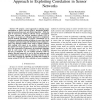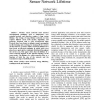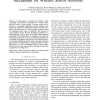ADHOC
2004
13 years 11 months ago
2004
We propose a novel approach to reducing energy consumption in sensor networks using a distributed adaptive signal processing framework and efficient algorithm 1 . While the topic o...
JRTIP
2007
13 years 11 months ago
2007
Abstract The problem of estimating and predicting position and orientation (pose) of a camera is approached by fusing measurements from inertial sensors (accelerometers and rate gy...
JPDC
2007
13 years 11 months ago
2007
We propose a novel vision for roadway safety warning based on sensor networks, aiming at providing user-friendly zero-delay safety warnings to motorists. Our idea leverages the ad...
JNW
2007
13 years 11 months ago
2007
— Wireless sensor networks must measure environmental conditions, such as temperature, over extended periods and therefore require a long system lifetime. The design of long life...
JNW
2007
13 years 11 months ago
2007
Abstract— In this paper, we propose and evaluate a selforganizing communication mechanism for wireless sensor networks where a large number of sensor nodes are deployed. To accom...
TSMC
2008
13 years 11 months ago
2008
This correspondence presents an approach to the detection and isolation of component failures in large-scale systems. In the case of sensors that report at rates of 1 Hz or less, t...
TPDS
2008
13 years 11 months ago
2008
The localization of sensor nodes is a fundamental problem in sensor networks and can be implemented using powerful and expensive beacons. Beacons, the fewer the better, can acquire...
TPDS
2008
13 years 11 months ago
2008
Communication is a primary source of energy consumption in wireless sensor networks. Due to resource constraints, the sensor nodes may not have enough energy to report every readin...
TON
2008
13 years 11 months ago
2008
This paper exploits the tradeoff between data quality and energy consumption to extend the lifetime of wireless sensor networks. To obtain an aggregate form of sensor data with pre...
TMC
2008
13 years 11 months ago
2008
In multihop wireless sensor networks that are often characterized by many-to-one (convergecast) traffic patterns, problems related to energy imbalance among sensors often appear. S...



